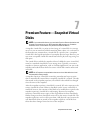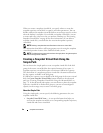
74 Snapshot Virtual Disks
•
Snapshot Repository Virtual Disk Full Conditions
— You can choose
whether to fail writes to the source virtual disk or fail the snapshot virtual
disk when the snapshot repository virtual disk becomes full.
•
Host-to-Virtual Disk Mapping
— Choose whether to map the snapshot
virtual disk to a host or host group now or to map the snapshot virtual disk
later
.
The default setting is
Map later
.
Preparing Host Servers to Create the Snapshot Using the Advanced Path
NOTICE: Before using the Snapshot Virtual Disks Premium Feature in a Microsoft
®
Windows
®
clustered configuration, you must first map the snapshot virtual disk to
the cluster node that owns the source virtual disk. This ensures that the cluster
nodes correctly recognize the snapshot virtual disk.
Mapping the snapshot virtual disk to the node that does not own the source virtual
disk before the Snapshot enabling process is completed can result in the operating
system mis-identifying the snapshot virtual disk. This, in turn, can result in data loss
on the source virtual disk or an inaccessible snapshot.
For details on mapping the snapshot virtual disk to the secondary node, refer to the
Dell PowerEdge™ Cluster SE600W Systems Installation and Troubleshooting Guide
on support.dell.com
The destination of a snapshot repository virtual disk is determined based on
the free capacity available in the disk group. A snapshot repository virtual disk
requires a minimum 8 MB of free capacity. You can choose your preferred
creation path—simple or advanced—if the disk group of the source virtual
disk has the required amount of free space.
If 8 MB of free capacity is not available in the disk group of the source virtual
disk, the Create Snapshot Virtual Disks feature defaults to the advanced
path (see "Creating a Snapshot Virtual Disk Using the Advanced Path" on
page 73). In the advanced path option, you can choose to place the snapshot
repository virtual disk in another disk group or you can use unconfigured
capacity on the storage array to create a new disk group.
NOTE: You can create concurrent snapshots of a source virtual disk on both the
source disk group and on another disk group.


















